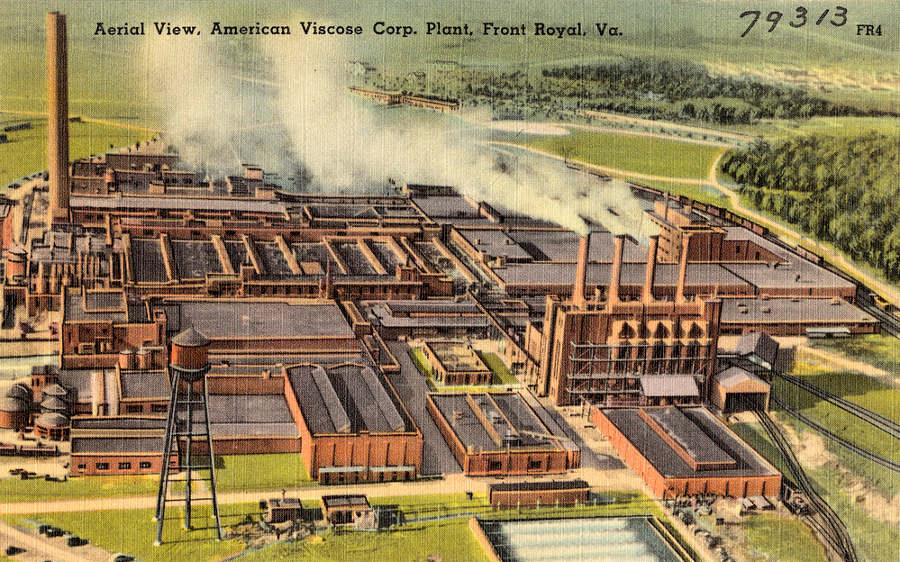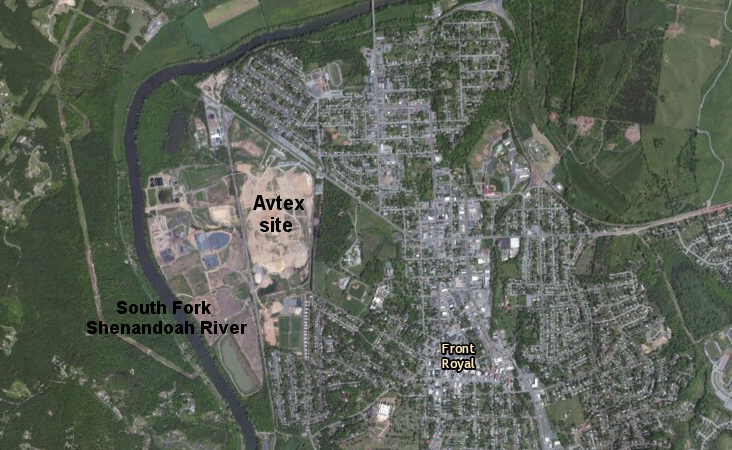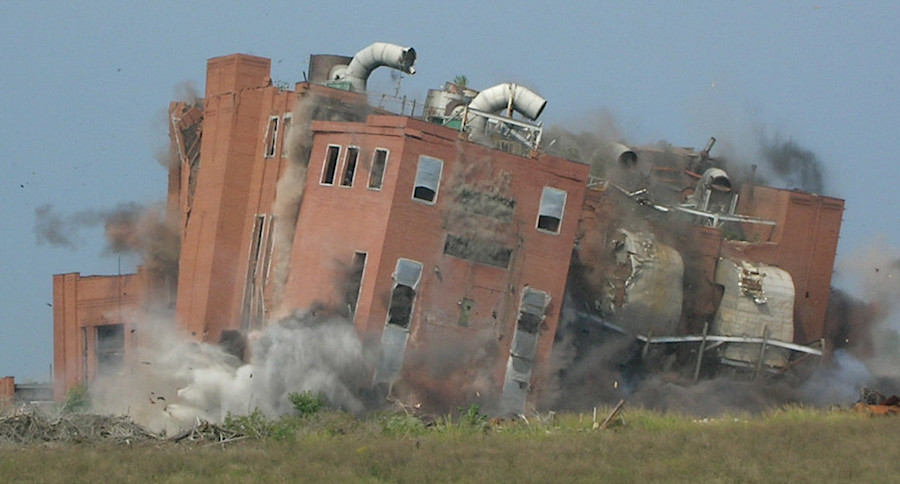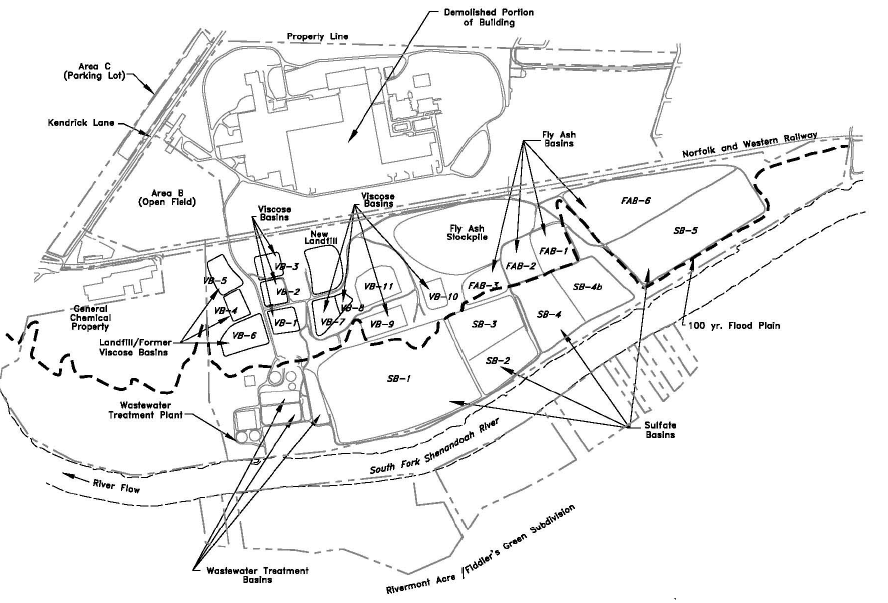
the American Viscose plant in Front Royal is a brownfield site that was cleaned up through the Superfund process
Source: Boston Public Library, Aerial view, American Viscose Corp. Plant, Front Royal, VA

the American Viscose plant in Front Royal is a brownfield site that was cleaned up through the Superfund process
Source: Boston Public Library, Aerial view, American Viscose Corp. Plant, Front Royal, VA
The Avtex Fibers Superfund site was a rayon-manufacturing complex covering 440 acres on the Shenandoah River in Front Royal. The fibers were used for parachutes in World War II and later to insulate the nozzles of rocket engines, including the solid rocket boosters that lifted the Space Shuttle into orbit. The facility was a major local employer operated by American Viscose between 1940-1963, FMC Corp. from 1963-1977, and finally by Avtex Fibers from 1977-89.
As part of the fiber production process, carbon disulfide, polychlorinated biphenyls (PCB's), arsenic, and other wastes were deposited into unlined basins, landfills, and open piles. Effluent was discharged into the South Fork of the Shenandoah River under a National Pollutant Discharge Elimination System (NPDES) permit, while groundwater was contaminated as much as 400 feet deep and hydrogen sulfide releases created a "rotten egg" smell in the area.
In the last five years of operations, the company fulfilled orders from Federal military and space agencies for viscose used to create a special version of rayon used in rocket engines, and ignored 2,000 State Water Control Board and court orders to reduce pollution or close.1
EPA designated Avtex as a National Priorities List site in 1986. Avtex briefly closed in 1988, re-opened after getting a new contract from the National Aeronautics and Space Administration, but eventually shut down the facility the day after the State Water Control Board revoked its water discharge permit in 1989.2
The company declared bankruptcy and quickly abandoned the site. It failed to protect its stockpile of carbon disulfide from conversion into a dangerous gas, and left $2 million worth of platinum and rhodium contained in rayon spinning jets.

location of Avtex Superfund site in Town of Front Royal
Source: ESRI, ArcGIS Online
Warren County seized the valuable metal and kept it in a jail cell, until bankruptcy courts determined how the material should be sold and the value distributed. The court awarded $20,000 to the county for storage, offsetting the loss of income loss from the inability to rent the cell to other jurisdictions.
Virginia recovered its costs for cleanup in a settlement with FMC Corp. and the Federal government. The Federal government had rescued Avtex in 1988, and extended the years of pollution by awarding NASA and Air Force contracts to Avtex despite its record of repeated water pollution violations.3
The original plans to lease/sell old Avtex buildings that covered 30 acres of land failed, during the long legal maneuverings to determine responsibility for the cleanup and removal of asbestos/lead from the buildings. Avtex was a ghost town during most of the 1990's.
The Environmental Protection Agency identified FMC Corp. as a "potentially responsible party" for cleanup, and in 1999 that company accepted responsibility for completing the project. Final cleanup included tearing down nearly all of the old buildings, digging up over 10 miles of sewer pipe, hauling away 3000 drums, removing contaminated soil/fly ash or encapsulating it beneath clay caps, and using the site's old water treatment plant to process leachate before it reached the Shenandoah River. The American Viscose Administration building was repurposed as the site cleanup headquarters.
The Economic Development Authority of Front Royal and Warren County took ownership in 2000. The FMC Corp. site manager for the cleanup noted that the Avtex cleanup was unusual, since land ownership was transferred to local authorities for productive use as parkland or redevelopment:4
On September 19, 2005, the US Army Corps of Engineers imploded the former boiler plant at the site. The building removal was intended to enable the construction of new buildings, so the Avtex property would become a new economic development opportunity rather than a perpetual burden on the local community.

repurposing the Avtex site for new development included removal of the Avtex Fibers Boiler House on September 19, 2005
Source: US Army Corps of Engineers, Avtex Fiber Boiler House (050919-A-1111A-016)
In 2014, EPA notified the Front Royal-Warren County Economic Development Authority that the Federal role had been completed. The Superfund Redevelopment Initiative had succeeded in converting the Avtex site from unproductive waste isolation to a business park and recreation site. After 25 years of remediation costing $150 million, much of the site was suitable for new building, while 240 acres above the old disposal basins were designated for long-term protection to keep remaining contaminated soil undisturbed.5
Redevelopment of the Avtex property was complicated when the Executive Director of the Front Royal-Warren County Economic Development Authority was accused of embezzling money. The Federal Bureau of Investigations (FBI) started an investigation in 2018. In 2021, criminal charges for bank fraud, wire fraud, money laundering, and aggravated identity theft were filed in the U.S. District Court for the Western District of Virginia against the former Executive Director. She and her accused co-conspirators reportedly diverted $21-26 million to their personal use.
By 2022, the former Executive Director had declared bankruptcy and repaid $9 million, in order to be released from further civil liability claims. Lawsuits in civil trials required other defendants to repay an additional $12 million. The defendants had failed to construct a planned data center on a 30-acre parcel at Avtex, or to hire 600 people.6
In 2023, a jury in the Federal court found the former Executive Director guilty on 34 counts of wire fraud, bank fraud, money laundering and aggravated identity theft. The jury rejected her claim that she had reached a secret agreement with the Front Royal-Warren County Economic Development Authority over claims of sexual harassment, and the agreement authorized her to spend $6.5 million of public money for personal use while disguising the transactions as official business.7
She began serving a 14-year jail sentence in 2024. By then she had been stripped of her assets through court proceedings. The Front Royal-Warren County Economic Development Authority reclaimed some of the money it lost through her fraud and money laundering, but ended up $20 million in debt.8

detailed diagram of Avtex site next to South Fork, Shenandoah River
Source: Environmental Protection Agency Site Map (Figure 1)